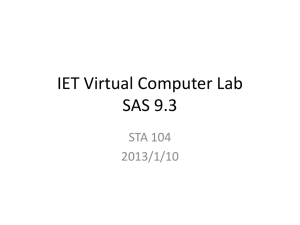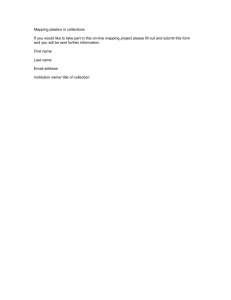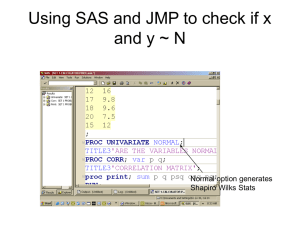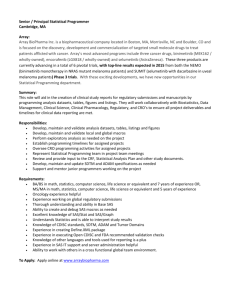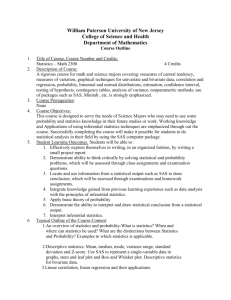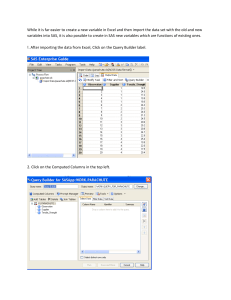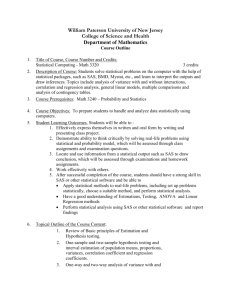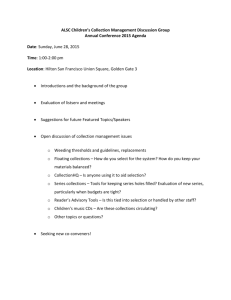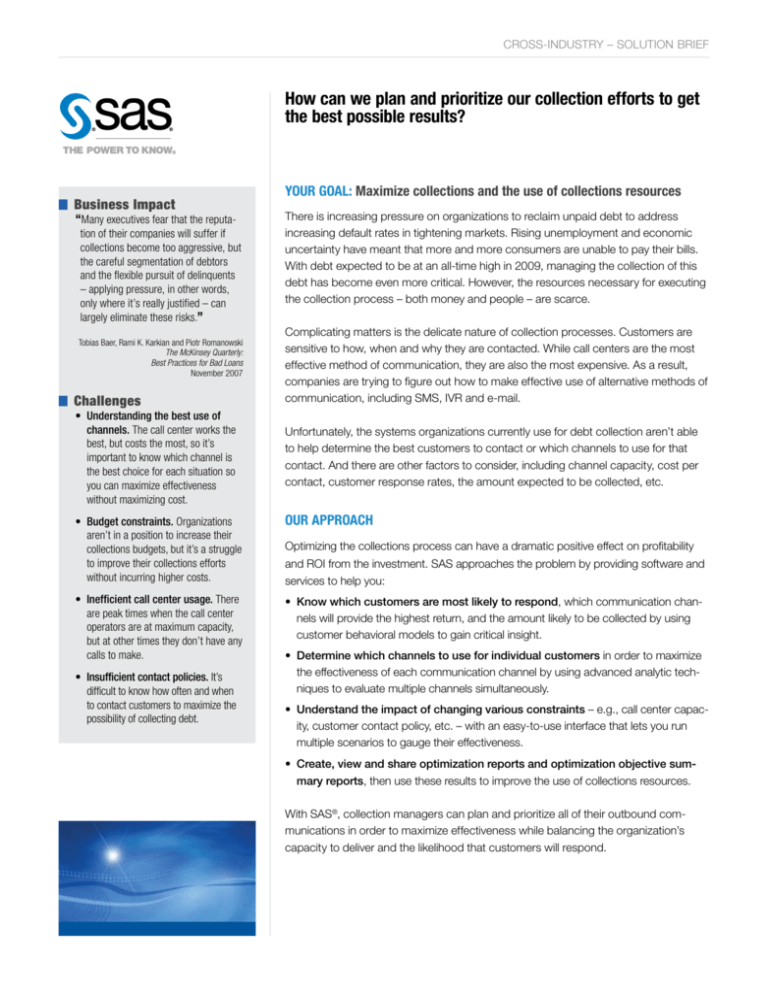
CROSS-INDUSTRY – SOLUTION BRIEF
How can we plan and prioritize our collection efforts to get
the best possible results?
Business Impact
“Many executives fear that the reputation of their companies will suffer if
collections become too aggressive, but
the careful segmentation of debtors
and the flexible pursuit of delinquents
– applying pressure, in other words,
only where it’s really justified – can
largely eliminate these risks.”
Tobias Baer, Rami K. Karkian and Piotr Romanowski
The McKinsey Quarterly:
Best Practices for Bad Loans
November 2007
Challenges
• Understanding the best use of
channels. The call center works the
best, but costs the most, so it’s
important to know which channel is
the best choice for each situation so
you can maximize effectiveness
without maximizing cost.
YOUR GOAL: Maximize collections and the use of collections resources
There is increasing pressure on organizations to reclaim unpaid debt to address
increasing default rates in tightening markets. Rising unemployment and economic
uncertainty have meant that more and more consumers are unable to pay their bills.
With debt expected to be at an all-time high in 2009, managing the collection of this
debt has become even more critical. However, the resources necessary for executing
the collection process – both money and people – are scarce.
Complicating matters is the delicate nature of collection processes. Customers are
sensitive to how, when and why they are contacted. While call centers are the most
effective method of communication, they are also the most expensive. As a result,
companies are trying to figure out how to make effective use of alternative methods of
communication, including SMS, IVR and e-mail.
Unfortunately, the systems organizations currently use for debt collection aren’t able
to help determine the best customers to contact or which channels to use for that
contact. And there are other factors to consider, including channel capacity, cost per
contact, customer response rates, the amount expected to be collected, etc.
• Budget constraints. Organizations
aren’t in a position to increase their
collections budgets, but it’s a struggle
to improve their collections efforts
without incurring higher costs.
our approach
• Inefficient call center usage. There
are peak times when the call center
operators are at maximum capacity,
but at other times they don’t have any
calls to make.
• Know which customers are most likely to respond, which communication channels will provide the highest return, and the amount likely to be collected by using
customer behavioral models to gain critical insight.
• Insufficient contact policies. It’s
difficult to know how often and when
to contact customers to maximize the
possibility of collecting debt.
Optimizing the collections process can have a dramatic positive effect on profitability
and ROI from the investment. SAS approaches the problem by providing software and
services to help you:
• Determine which channels to use for individual customers in order to maximize
the effectiveness of each communication channel by using advanced analytic techniques to evaluate multiple channels simultaneously.
• Understand the impact of changing various constraints – e.g., call center capacity, customer contact policy, etc. – with an easy-to-use interface that lets you run
multiple scenarios to gauge their effectiveness.
• Create, view and share optimization reports and optimization objective summary reports, then use these results to improve the use of collections resources.
With SAS®, collection managers can plan and prioritize all of their outbound communications in order to maximize effectiveness while balancing the organization’s
capacity to deliver and the likelihood that customers will respond.
The sas® difference: Greater effectiveness and profitability in collections
Tapping into more than 30 years of experience with optimization, SAS has developed
a patented, custom algorithm for collections that includes innovative new approaches
born from that experience. With SAS, you get:
• Effectiveness. SAS uses true, mathematical optimization to consider all factors and
provide the best of all possible solutions.
• Speed. While complex mathematical computations have typically caused processing bottlenecks, the patented SAS algorithm reduces optimization approaches from
days to minutes, giving managers quick and easy access to accurate information for
making smarter decisions.
• Ease of use. An intuitive interface allows users who know nothing about optimization techniques to enter objectives, constraints and contact policies and run all
reports and analyses.
• Integration. Based on the same robust, flexible framework as other SAS solutions,
our marketing optimization solution enables you to take advantage of existing technology investments, which decreases your total cost of ownership.
Only SAS combines mathematical optimization, user-defined constraint modeling and
integration with industry-leading predictive analytics, enabling you to reach the next
level of effectiveness and profitability in collections management.
The Vision
More for less
What if you could maximize total collections by simultaneously optimizing the
expected amount to be collected, the
preferred communication channel, and
the likelihood of response?
Maximum channel effectiveness
What if you could determine the best
communication channel to use for each
collection opportunity?
Reduced collections budget
What if you could improve your
efficiency and actually increase
collections for less cost?
Optimal contact policy
What if you knew which contact policy
to enforce for maximum effectiveness
and understand how often and when
to contact customers to maximize the
possibility of collecting debt?
CASE STUDY: A large financial services institution
Situation
The bank’s collections manager was facing a growing number of issues. Hundreds
of thousands of customers were in a collection status, but the limited budget for
collections was shrinking rapidly. While there were several collections channels to
choose from, there was no way to determine which channel to use for individual
customers. Previously, these decisions were left to a sorting and prioritization
scheme. But with multiple channels and limited channel capacity, the bank wanted
to move beyond standard collection solutions to increase balances collected.
Solution
SAS provided the bank with a collections optimization solution that included:
• An easy-to-use, intuitive interface.
• Robust optimization formulation.
• SAS has been in business since
1976 and today has customers at
more than 45,000 sites worldwide.
• SAS customers make up 91 of the
top 100 companies on the 2008
FORTUNE Global 500®.
• CRM magazine has named SAS the
leading provider of CRM analytics for
four consecutive years.
Learn more about SAS software
and services at: www.sas.com
• Flexible scenario analysis capabilities.
Results
• Increased daily recovered balances by an average of $100,000.
• Reduced operating costs by more than $1 million annually.
• Reduced bad and doubtful debts by more than $3 million annually.
• Based on early results, the ROI from this project will exceed expectations.
SAS Institute Inc. World Headquarters
S A S FAC T S
+1 919 677 8000
To contact your local SAS office, please visit: www.sas.com/offices
SAS and all other SAS Institute Inc. product or service names are registered trademarks or trademarks of SAS Institute Inc. in the USA and other countries.
® indicates USA registration. Other brand and product names are trademarks of their respective companies. Copyright © 2009, SAS Institute Inc.
All rights reserved. 103920_534569_0409

